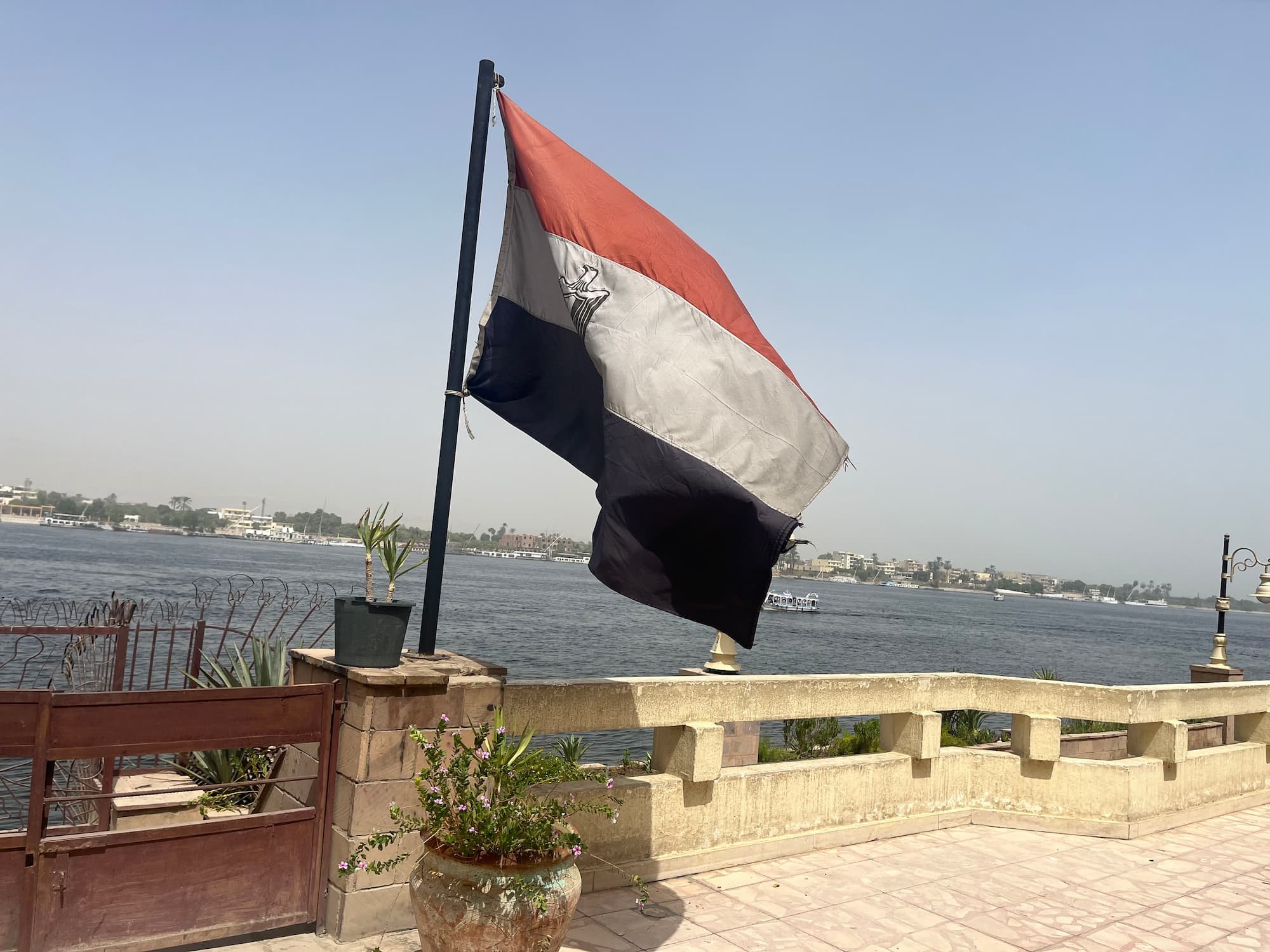Admiring the Egypt flag flying proud in Africa.
Walking along the River Nile in Luxor, I noticed yet another Egyptian flag flying high.
The locals in every city are proud of their country and their flag of Africa.
Throughout my Egypt trip, I kept seeing the tricolour flag and famous colours of red, black, and white decorating famous landmarks, boats, and while I was on my city break in Cairo, I saw many flags hanging from the unfinished towering housing blocks.
So what is the meaning behind the iconic eagle logo, and what do Egypt’s famous colours signify?
The flag represents an important aspect of the nation’s more recent history!
The Egypt flag is a common site along the River Nile.
The history of the Egypt Africa Flag.
Although Egypt’s history is vast, dating back thousands of years, its first true national flag is just over a century old.
Its more recent history, which formed the famous striped colours of red, white and black was as a result of the 1952 revolution that overran the monarchy.
Previously, flags had displayed green colours, a crescent moon, and some stars.
From 1972 to 1984, Egypt flew a flag with two stars and a golden Hawk of Quraish, symbolising unity with fellow Arab states. But, when the union dissolved, the hawk felt somewhat...redundant. Enter the glorious Eagle of Saladin, replacing the hawk in 1984.
This wasn't just any eagle; it was the emblem used on the 1958 flag, a symbol of liberation and national pride linked to the legendary mediaeval Muslim leader.
Bringing it back was like dusting off a treasured heirloom, reconnecting with Egypt's independent spirit while acknowledging its roots in Arab unity.
The Citadel of Qaitbay in Alexandria.
The meaning of the colours.
There is meaning behind each of the colours on the current flag, which make for some interesting facts on Egypt.
Red.
The red represents blood, and the large amount spilled in struggles against oppression and colonisation, especially in the revolution.
White.
A more peaceful aspect of the flag, with it symbolising peace and purity, and the hope that the future will be this way following overcoming oppression.
Black.
The black at the bottom of the flag denotes the darkness and hardship endured under foreign rule and a victory over tyranny.
During my solo trip to Egypt, I noticed that all three colours are displayed in equal measure throughout the different cities in Egypt.
In the back streets of Cairo I noticed many walls and shutters painted predominantly red and black, with some of them being very good photo spots.
The museums in Egypt also displayed the flags at the entrances, and whilst in the city of Luxor, I also noticed many of the souvenirs in Local Market also exhibiting the iconic colours.
Local culture in Cairo.
The Eagle of Saladin Emblem.
The Eagle of Saladin, adorning Egypt's flag, along with other Arab nations, boasts a rich history and potent symbolism.
Origin:
Adopted by 12th-century Sultan Saladin, the eagle, likely inspired by ancient Egyptian depictions, represented strength, leadership, and victory. He used it on his personal standard and the empire's flag.
Evolution:
The headless eagle on Cairo's Citadel, possibly once double-headed, reflects its transformation beyond Saladin's rule. It became a symbol of Arab nationalism, adopted by many nations seeking independence.
Modern Meaning: Today, the golden eagle on Egypt's flag signifies:
Independence:
Soaring wings evoke freedom from colonial powers.
Strength:
Its sharp gaze and powerful talons represent resilience and military prowess.
Pan-Arabism:
Its presence on several Arab flags unites them under a shared heritage.
Interesting laws around the Egypt flag.
The Egyptian flag carries significant cultural and historical weight, so I wasn’t surprised to learn that there are some interesting laws and regulations surrounding its use:
Flag Etiquette:
Flying the flag at half-mast is only permitted during official mourning periods declared by the government. Displaying it upside down is considered a grave insult and can lead to legal repercussions.
Respecting the Eagle:
The golden Eagle of Saladin on the flag is a protected symbol. Defacing or damaging it is considered an offence against the state and can be punishable by fines or imprisonment.
Commercial Use Restrictions:
Using the flag for commercial purposes without proper authorization is prohibited. This includes using it on products, packaging, or advertisements without permission from the government.
Flag Day Celebrations:
On June 23rd, Egypt celebrates National Flag Day. On this day, displaying the flag prominently is encouraged, and government buildings and institutions are adorned with it.
Sporting Events:
During international sporting events where Egypt participates, supporters are allowed to display the flag, but in a respectful manner. Using it to incite violence or hatred against other nations is forbidden.
Flying proud at iconic landmarks.
Every famous landmark I visited in Egypt had the flag on display somewhere on site, whether it was the ticket office at the Temple of Hatshepsut, Luxor Temple, and Karnak Temple, or at various points on the island at the Temple of Philae.
Egypt flags can be found across the iconic landmarks.
Speaking to a local about the Egyptian flag.
During my evening exploring Luxor Market, I had an authentic cultural experience chatting to a local over an Egyptian tea. He was explaining some of the unwritten cultural norms surrounding the flag.
He was saying that Egyptians hold it in high regard and view it as a symbol of national pride and unity. Treating it with respect and displaying it appropriately is considered important by most of the population.
‘Eddie’, the local, was saying that his older generation connected the flag to the 1952 revolution and the liberation from colonial rule, instilling a sense of national pride and gratitude. The flag is viewed as a potent symbol of their nation's identity, resilience, and achievements.
He also said that Egypt isn’t politically stable, and there are parts of the population who question its representation of the current government and its policies, raising concerns about political dissent and human rights issues!
Discussing the local culture, including the flag.
The Egyptian flag colours cover the trains, taxis and boats.
As I walked around the various train stations in Luxor, Aswan and Cairo, I noticed the Egyptian flag colours throughout the stations, including the cafes, waiting rooms and platforms.
The sleeper train from Cairo to Luxor was decorated in the famous black, white and red colours which was very interesting, as the train from Luxor to Aswan I caught was a different colour.
The trains aren’t the only modes of transport that display the flags.
I experienced many taxi drivers decorating their vehicle with flags, or ornaments in red, white and black. This was mainly in Cairo and the southern city of Aswan.
You will also struggle to experience a ride on the Nile without seeing the famous colours. Felucca boats, boat taxis, and cruise ships all showcase the colours of Egypt.
The colours of Egypt cover the trains.
Which landmarks are you visiting first?
Visiting Egypt soon, and not sure which landmarks you want to visit?
Here are a few underrated gems for you to add to your typical travel itinerary.
Saqqara Necropolis is home to the oldest pyramid in the world, along with some famous tombs, all dating back thousands of years. You can reach the site by car in around 45 minutes, and it is a much more enjoyable experience than the Giza pyramids.
My favourite setting for a landmark in Egypt is the Temple of Philae, which sits on the beautiful Agilika Island, just a few miles from Aswan.
This makes for a great day activity on any Aswan itinerary.
An underrated site in Luxor is the Colossi of Memnon, which is world famous, as a result of the ‘mysterious singing’ which occurs from the statues at sunrise. This is a great spot for a free stop on your way to the main West Bank sites.
If you want to ride a camel in Egypt, then some pre-planning is essential, to ensure you choose the right spot, and to avoid the common scams, especially at the Giza Plateau!
Disclosure: I sometimes use affiliate marketing. This will not cost you anything, but helps with my travel costs. I only recommend companies I use myself.








